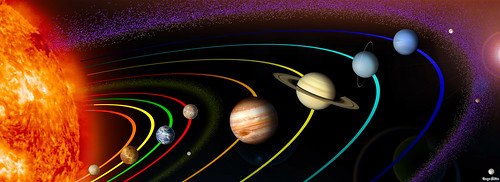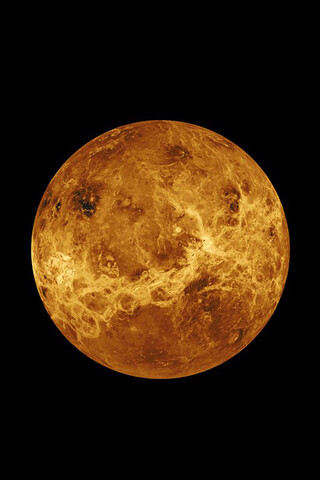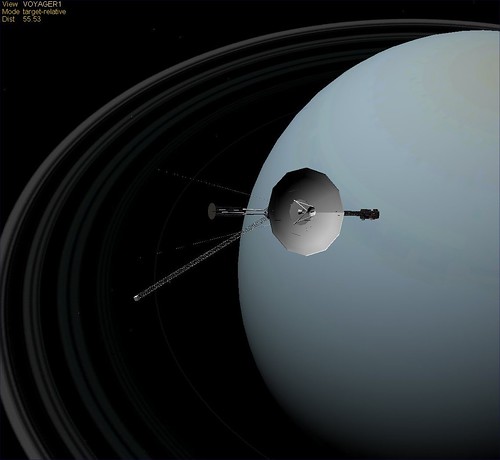| |
|
 | | 01 The Solar System PIA10231, mod02 | by Image Editor on Flickr |
| The Solar System is everything that orbits the Sun
|
 |
| Mercury on Sun - Rare Transit |
by edhiker on Flickr |
|
The Sun: Star
- Hottest thing in our Solar system
- 435000 miles - the size of about 1000 Jupiter's!
- Only star in our Solar system
- In it's prime of life (only 4 billion years old). It will live for another 4 billion years
- 70 % hotter than 1 billion years ago
- All planets, dwarf planets, asteroids, meteors, meteoroids and comets orbit the Sun
|
The Inner Solar System - Is the four rock planets and the asteroid belt
|
 |
| NASA Satellite MESSENGER Sends Back First Image of Mercury from Orbit |
by NASA Goddard Photo and Video on Flickr |
|
Mercury: Rock planet
- First planet from the Sun
- Second hottest planet
- No natural satellites
- Big iron core
- Small thin mantle
- Most of it's mantle was stripped off by a huge crash with a asteroid about 3 billion years ago
|
 |
| Venus |
by chrismeller on Flickr |
|
Venus: Rock planet
- Hottest planet
- Second planet from the Sun
- Close to the same size as earth
- No natural satellites
- Much drier then earth
- Average temperature is 400 degrees Celsius
- Has volcanic eruptions
|
 |
| Earth, courtesy Apollo 17, and probably the most reproduced image of all time |
by woodleywonderworks on Flickr |
|
Earth: Rock planet
- The only planet known to have life
- Third planet from the Sun
- Has one satellite the moon
- The only inner planet that has a big moon
- The only planet with plate tectonics
- Atmosphere is 21% oxygen
- Biggest inner planet
|
 |
| Planet Mars |
by cosmobc on Flickr |
|
Mars: Rock planet
- Fourth planet from the Sun
- Has water in icecaps
- Most Earth like planet
- Coldest inner planet
- Smaller then Earth and Venus
- Has the biggest volcano in our Solar System Olympus Mons
- Has our Solar Systems biggest valley Valles Marineris
- Has two moons Phobos and Deimos
- About half the size of Earth
|
The Asteroid Belt - Is the remains of a planet that couldn't form due to Jupiter's gravity!
- It orbits the sun in between Mars and Jupiter.
- All objects in the asteroid belt are not planets or dwarf planets except for Ceres
|
Ceres: Dwarf Planet
- Closest Dwarf planet to the Sun
- First dwarf planet found in the asteroid belt
- Largest asteroid
- Used to be considered a planet when it was found
- Was reclassified a asteroid when more asteroids where discovered
- In 2006 it was reclassified a dwarf planet
- Has a diameter of slightly under 1000 kilometers
|
The Outer Solar System - Is the Gas Giants, Ice Giants and the centaurs.
|
 |
| Jupiter |
by chrismeller on Flickr |
|
Jupiter: Gas Giant
-
Fifth planet from the Sun
-
Biggest planet
-
318 Earths could fit in it!
-
About 2 times the size of all of the planets put together!
- Made mostly of Hydrogen and Helium
- Has the biggest storm in the Solar System the great red spot
- Has 64 satellites
- The largest satellite Ganymede is bigger then Mercury
- Ganymede is the largest satellite in the world
- Has very thin rings
|
 |
| Saturn |
by chrismeller on Flickr |
|
Saturn: Gas Giant
- Sixth planet from the Sun
- Second biggest planet
- Has the biggest set of rings in the Solar System
- The size of 95 earths
-
It's rings are made up of rock and ice
-
has 62 satellites
-
It's largest satellite Titan is bigger then Mercury
-
Titan is the second largest satellite in the Solar System
-
Titan is the only Satellite with a atmosphere
|
 |
| Voyager Uranus |
by FlyingSinger on Flickr |
|
Uranus: Ice Giant
-
The size of 14 Earths
-
The lightest outer planet
-
Orbits the sun on it's side so half the year there is light on one side and no light on the other
-
Core is much colder then the other outer planets
-
Radiates very little heat into space
-
Has 27 natural satellites
-
Seventh planet from the Sun
|
 |
| Voyager Neptune |
by FlyingSinger on Flickr |
|
|
Trans-Neptunian region: Is the area beyond Neptune, which is mostly unexplored
|
The Kuiper belt: Is much like the asteroid belt but everything is made mostly out of ice. It can be divided into the classical belt objects that don't have a resonance with Neptune and the Resonance belt objects that do.
|
 |
| New Horizons at Pluto - Orbiter |
by FlyingSinger on Flickr |
|
|
Haumea: Dwarf planet- Egg shaped
- Has two natural satellites
- Orbit is tilted by 28 degrees
Makemake:Dwarf planet- Second brightest object in the Kuiper belt after Pluto
- Orbit is inclined by 29 degrees
|
The Scattered Belt: Is thought to be the source of short period Comets and objects that where scattered by Neptune's gravity.
|
Eris: Dwarf planet
- Largest object in the scattered disc
- 25% percent more massive then Pluto
- The most massive dwarf planet
- Has one moon Dysnomia
- Orbit is steeply inclined
|
The Oort cloud: Is made of a trillion icy objects that orbit the Sun a light year away it is also thought to be the source of long period comets.
|
Scattered disc Sedna: Most likely a Dwarf planet- Large and Red
- Has a large and steeply inclined orbit
- Orbit takes 12,050 years to complete
- Thought to be a part of an entirely new population
- Founder says that it can not be a part of the scattered disc or the Kuiper belt because it goes to far away from the Sun
- Most likely a dwarf planet but it's shape has not been confirmed
|
 NeoK12.com - Educational Videos, Lessons, Quizzes & Presentations
NeoK12.com - Educational Videos, Lessons, Quizzes & Presentations









